E-commerce software like WooCommerce has revolutionized online retail, making it accessible for businesses of all sizes to establish their digital storefronts. While WooCommerce remains a popular choice due to its free, open-source nature and extensive customization options, my experience with various e-commerce platforms has shown that there are compelling WooCommerce alternatives ⇣ worth considering for your online shop.
The e-commerce landscape has transformed dramatically since Amazon’s early days of selling books. Today, online transactions dominate global commerce, with platforms like WooCommerce playing a crucial role in this digital marketplace revolution.
Based on my hands-on experience with numerous e-commerce solutions, here’s a quick rundown of the top alternatives:
- Best overall: Shopify ⇣ stands out as the premier all-in-one e-commerce platform. Its robust feature set and user-friendly interface have consistently impressed me, enabling even non-technical users to create professional online stores quickly.
- Runner-up, Best Overall: BigCommerce ⇣ offers a compelling hosted e-commerce solution. Its standout feature, in my experience, is the seamless WordPress integration, allowing you to leverage WordPress’s content management strengths while BigCommerce handles the e-commerce backend.
- Best free alternative to WooCommerce: Ecwid ⇣ provides an excellent e-commerce shopping cart that integrates smoothly with WordPress. I’ve found its Forever-Free plan particularly valuable for small businesses or those just starting out with a limited product catalog.
Top Alternatives to WooCommerce in 2024
After testing and implementing numerous e-commerce solutions for clients across various industries, I’ve identified the following alternatives to WooCommerce that offer enhanced features and functionality for building robust online stores:
Start selling your products online today with the world’s leading all-in-one SaaS e-commerce platform that lets you start, grow, and manage your online store.
Start a free trial & get three months for $1/mo
- Fully hosted and all-in-one platform meaning you don't have to worry about the technical stuff. Huge (free and paid) app marketplace, and custom themes. Abandoned cart recovery, 100+ payment gateways, simple to use storefront, SKU and inventory management, built-in SEO, marketing, analytics, and reporting, flexible shipping rates and automatic taxes. Excellent customer support, self-help documentation, and community. Sell across multiple channels, both digital and physical products (integrated POS). All features.
- Shopify’s built in payment processor only allows you to sell from certain countries, and you have to pay transaction fees if you use third-party payment gateways. The cost of using apps can quickly add up. Email hosting isn’t included. The Starter plan comes with limited Shopify features.
1. Shopify

What is Shopify?
Shopify was launched in 2004. It’s one of the leading platforms right now, and one of the first viable alternatives that users consider when they switch over from WooCommerce. If you want the ease of use for both you and your customers, Shopify is a great choice.
Did you know that over 1 Million businesses in 175 countries have made more than $155 Billion USD in sales on Shopify
Shopify allows you to build an eCommerce site without writing a single line of code. They help manage everything for your online store, including payment processing, generating invoices, managing your catalog, and everything else you need to run a successful online store.

Key features:
- Acceptance of 70 payment gateways, including credit card and PayPal.
- A professional point-of-sale system that functions entirely online.
- Automatic fraud analysis.
- Read my Shopify review for more features.
- Shopify pricing starts from $29/month
Pros:
- Shopify is one of the easiest ways to build an online store for your online business.
- Shopify takes care of the backend technical maintenance of running an online store for you.
- Automatic fraud analysis for transactions that get flagged.
- 100+ professional themes (both free and paid).
- The ability to list an unlimited amount of products and unlimited bandwidth.
Cons:
- The plans aren’t free, but they are worth paying for.
- Shopify Lite (for mobile) can be lacking in features as opposed to the full version.
Why use Shopify instead of WooCommerce?
Simply, Shopify is cheaper than WooCommerce in the long run – but this shouldn’t be your only reason for switching platforms.
Shopify is also easier to use and offers better customer support that’s available when you need it – and offers more payment solutions than its e-commerce competitors in order to make selling online an easier process.
Compared to WooCommerce, Shopify provides fully hosted solutions, has SLA-based support, and is independent of WordPress.
2. Wix

What is Wix?
Just like WordPress, Wix is a platform that’s best known for helping people to set up free websites and blogs for their brands and businesses.
It doesn’t just help you to build websites, but it’s also a good way of building an eCommerce website too.
Thousands of people choose Wix, and it has become one of the strongest alternatives alongside WooCommerce and Shopify, currently powering millions of websites all over the internet.
Key features:
- Wix has a free plan and paid alternatives for people who want to set up an eCommerce website.
- The Wix Website Builder is easy to use, although might become limiting for larger websites or more advanced users.
- Wix allows you to build websites according to templates, which is great for users who are still finding their feet around building a website.
- Wix pricing starts from $16/month

Pros:
- Wix is very easy to use if you’ve never built a website or e-commerce store before.
- 100s of templates and drag-and-drop website builder that is made with beginners in mind. Wix websites are easy to put together, but there’s a lack of coding ability for more advanced users who already know what they would like to build.
- Buying and selling through the Wix e-commerce platform is easy.
Cons:
- One of the first cons of the Wix platform is the fact that all websites built on the free plan come are obviously a “Wix site” with the Wix domain – unless paid.
- Paying for Wix is cheap for the first few months, but is likely to get expensive in the long run.
- Wix isn’t primarily built with eCommerce in mind, is a bit limited in this space.
Why use Wix instead of WooCommerce?
WooCommerce is the eCommerce partner for WordPress: If your website has been put together with WordPress, then you might want to side with WooCommerce – but if you have a Wix site, then you might want to choose Wix for your eCommerce website instead.
Compared to WooCommerce, Wix is a lot more beginner friendly and easier to use when starting an online store.
3. Bigcommerce

What is Bigcommerce?
Bigcommerce is an eCommerce solution that a lot of users out there might not have heard of yet, but this doesn’t make it lacking in either features or functionality.
Bigcommerce stands on its own, and it’s just as powerful as equivalents such as Shopify – and Bigcommerce is great for eCommerce ventures who don’t want their selling platform to have a lot of fuss to it.
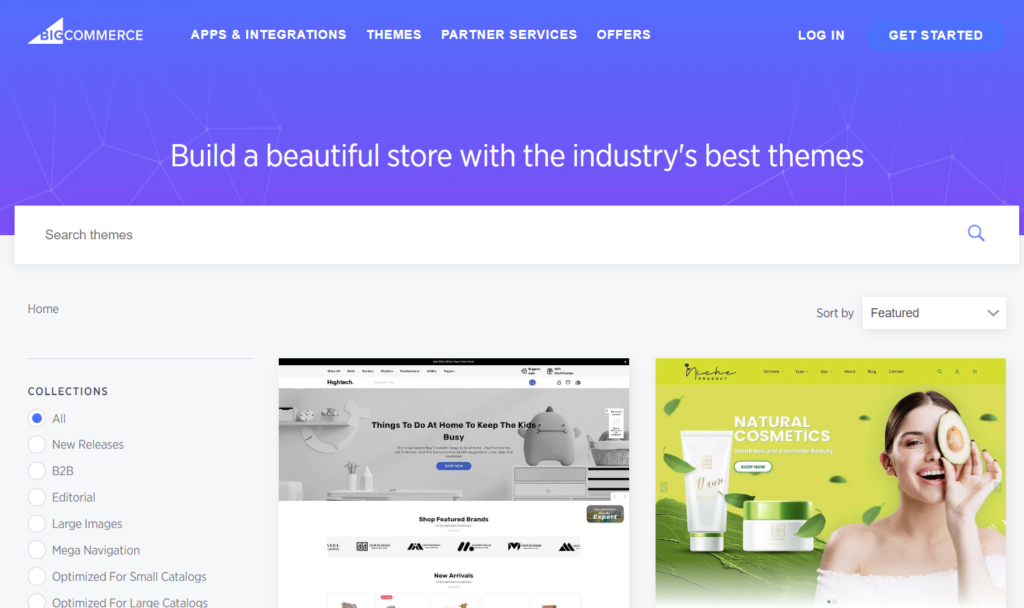
Key features:
- Bigcommerce integrates with WordPress and has the frontend powered by WordPress and the backend by Bigcommerce.
- The option of integrating your eCommerce selling platform with several different site options, whether your main site is based in WordPress, Wix, or any other of the options out there.
- E-commerce software that is scalable and suits large and small business ventures alike.
- Bigcommerce happens to support several payment options, whereas some e-commerce options are limiting (especially for international customers or clients).
Pros:
- Bigcommerce offers a training program for anyone who is new to the business of e-commerce and sales.
- The Bigcommerce platform allows you to market your products right from the platform instead of needing any other add-ons.
- Store setup and design are pretty easy, even for novices.
Cons:
- Expensive, especially for larger online stores and long-term users.
- It’s been criticized for being hard to use when it comes to specific features such as inventory management.
- Bigcommerce prefers exclusivity: Either use them or switch completely!
Why use Bigcommerce instead of WooCommerce?
If you’re using WooCommerce right now, it’s likely that you’re going to want to switch to Bigcommerce just because it happens to be easier: While Bigcommerce has received criticism for being hard to navigate, the same can be said for WooCommerce.
If you want an easy-to-use platform that isn’t a nightmare to navigate, neither might be best: Choose Shopify!
4. Ecwid
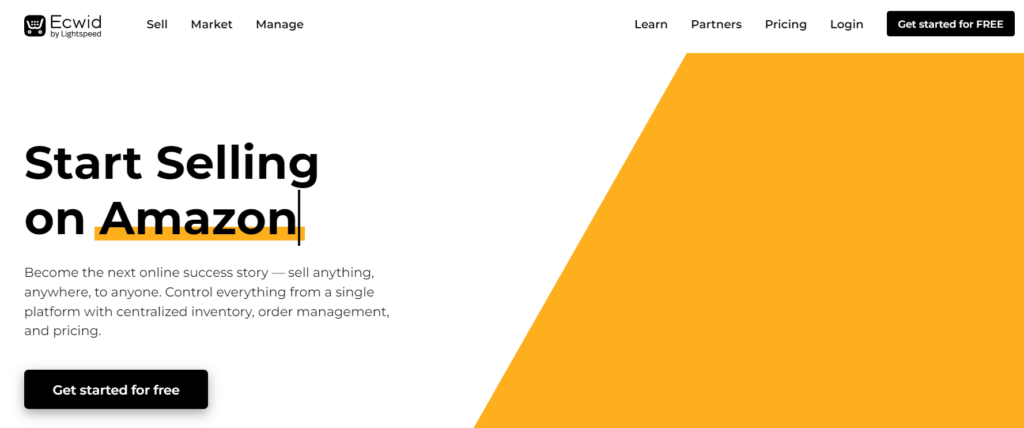
What is Ecwid?
Ecwid is one of the more obscure e-commerce options (and it might not be as famous as Shopify or WooCommerce), but it has become an option that can hold its weight when compared to the rest.

Key features:
- An automated selling process from start to end with very little need to interfere beyond setting your specifications.
- Mobile-friendliness is something that a lot of eCommerce platforms can’t say for their selling platform.
- Easy inventory no matter how many items you sell through it.
- You can easily sync and sell across your website, social media, and marketplaces like Etsy and Amazon.
Pros:
- Their “Free Forever” plan is useful for anyone who would like to start an online shop.
- Their selling tools are easy-to-use, but only once you get the hang of things.
- Inventory management is easier through Ecwid than through comparative e-commerce platforms out there such as WooCommerce.
Cons:
- Even though Ecwid is a strong WooCommerce competitor for the mainstream selling options, it has still received a lot of criticism for being harder to use than platforms like Shopify.
- Ecwid has a “Free Forever” plan, but this is very limiting for advanced users who want to control every aspect of the selling process.
- Signing up with Ecwid is cheap, but once you want to get more out of it, you’ll pay more, too.
Why use Ecwid instead of WooCommerce?
If you’re using WooCommerce right now, then even the free plan of Ecwid is a better option than the paid options for WooCommerce.
In terms of control and functionality, options like Ecwid and Shopify are worlds better than what you’re used to if you’re a traditional WooCommerce user.
5. WP eCommerce
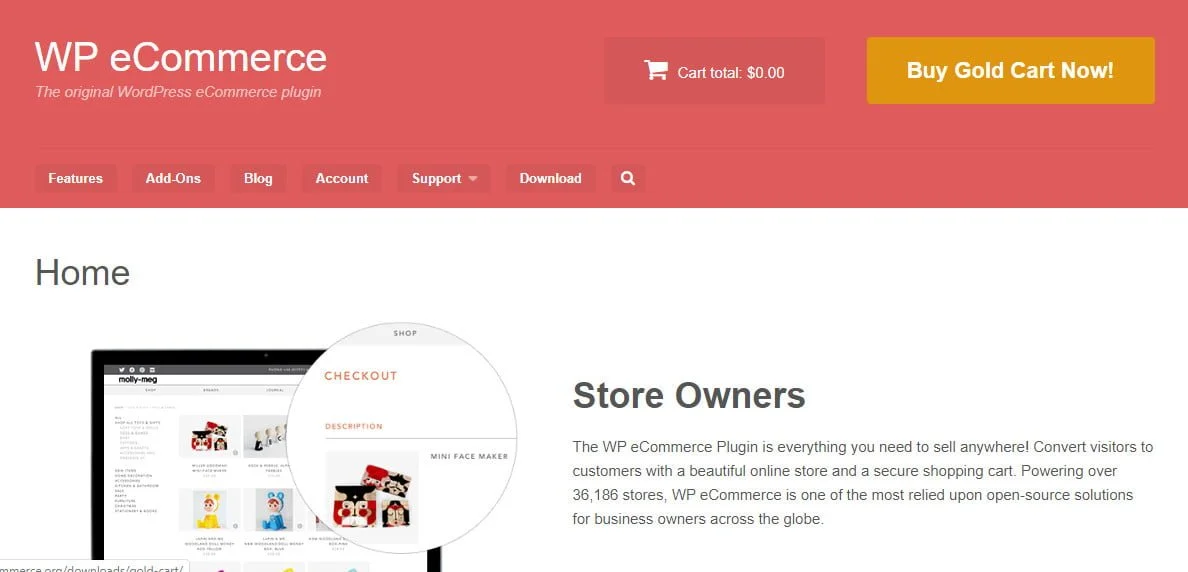
What is WP eCommerce?
WP eCommerce is one of the best eCommerce options to sign up with if you’re new to the business (or want to switch your commerce option over from what you have now).
It works well for both advanced users and novices but can get expensive if you want more functionality.
Key features:
- WP eCommerce is easy-to-use when it comes to setting up your platform and selling.
- Added features of WP eCommerce include the option to add coupon codes and other useful things for your users.
- Mobile users can find their way around the platform without having the number of features they have access to affected by this.
Pros:
- One of the best things about WP eCommerce is the fact that it’s easy to set up and easy to use, whether you have a small store or a large one.
- The addition of useful features such as coupons for customers makes WP eCommerce great.
- The customer support that WP eCommerce offers is decent, but unfortunately “decent” is all they can say.
Cons:
- If you’re thinking of switching from WooCommerce, then eCommerce is far too similar to be worthwhile.
- WP eCommerce is easy to use, but becomes harder to use the more you would like to do with it: Larger stores mean more effort.
- WP eCommerce is an option that becomes expensive if you choose to level it up beyond their free plan.
- The design feels pretty outdated and looks like it hasn’t been updated for quite some time.
Why use WP eCommerce instead of WooCommerce?
WP eCommerce might offer an easier-to-navigate alternative to WooCommerce, but the reality is that it’s still run and owned by WordPress. This is an unfortunate fact that means you’re stuck with the same cons you hated if you were a WooCommerce user!
6. Square E-commerce

What is a Square?
Square is best known for its POS terminal but they also do eCommerce software. Square is a great e-commerce platform for any newcomers to the online selling space. Their easy-to-navigate platform can be integrated into any main website within just a few minutes – and it’s easy to sell stuff using the main platform once you get going.
Key features:
- A free plan that comes with 500MB of storage and payments is exclusively done via Square.
- Free or paid eCommerce plans that are suited to large or small stores.
- Mobile-friendly selling and buying options make this worthwhile.
- Upgraded plans are available for users who want to expand their reach, network, and available features.
Pros:
- Square is easy to use, comes with a free plan, and is ideal for low-volume e-commerce stores.
- One of the main pros of using Square is the fact that the platform guides you through the first steps of setup whereas many other commerce platforms leave you in the dark.
- Plenty of useful features can be added for customers, including discounts, special offers, and coupon codes with just a click.
- Several payment options are supported through Square, including PayPal.
Cons:
- Simply, Square isn’t the cheapest and you’re better off with alternatives like Shopify if you’re on a budget.
- Sometimes Square can be hard to navigate for newcomers to use.
- Limited features, customization, and payment options.
- Tech support isn’t always as useful as it should be.
Why use Square instead of WooCommerce?
If you’re using WooCommerce right now, consider a switch to Square: When compared to the free options, you might still prefer using the functionality of WooCommerce just because you get more out of it – but once you start talking about paid options, Square becomes worlds better for the money.
7. Webflow
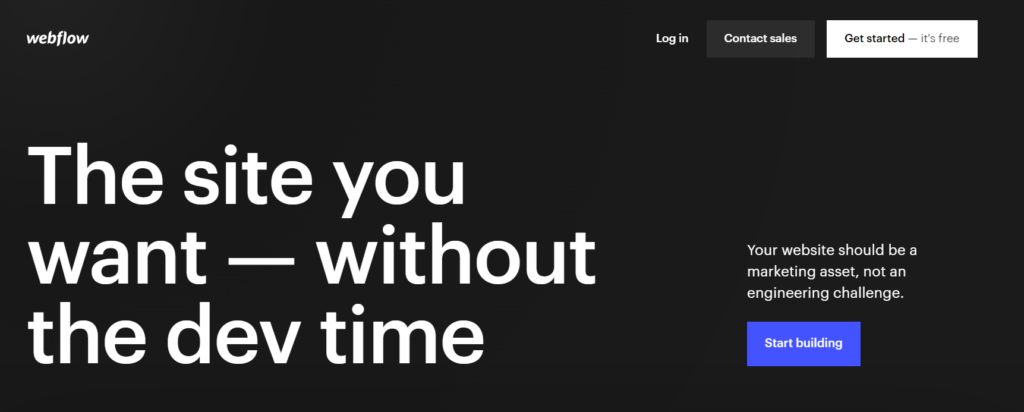
What is Webflow?
Webflow hasn’t been around for as long as other options like WooCommerce and Shopify, but it’s grabbed a pretty large chunk of the overall market share already. With Webflow Ecommerce, you can build and design your online store, and customize every little detail of your website, shopping cart, and checkout experiences.
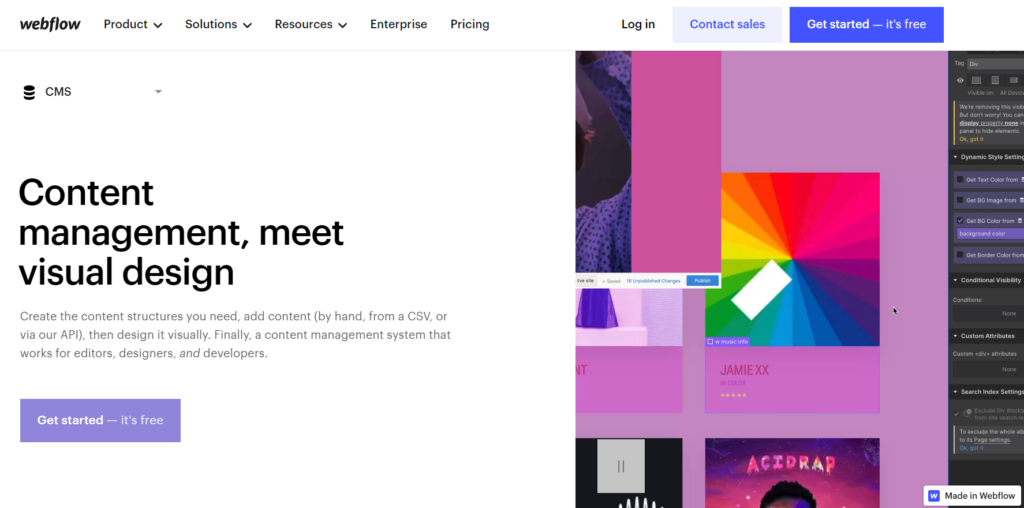
Key features:
- Webflow’s visual “no-coding” builder lets you customize every little detail of your website, shopping cart, and checkout experience.
- The option to list an unlimited amount of items for sale through the inventory.
- Coupon codes and special offers or discounts for customers, which you can add with just a few clicks.
- Free plans or paid plans depending on what you’re looking for.
Pros:
- Webflow gives you complete design freedom, it’s a completely customizable eCommerce platform.
- The selling platform for Webflow is easy-to-use.
- Integration is easy and seamless, whether you know HTML or not – and whether you’re used to commerce selling platforms or not.
- Webflow supports a few more payment avenues than other forms of selling platforms.
- For more features see my review of Webflow here.
Cons:
- Webflow is primarily built for web designers launching websites, and e-commerce capabilities were added later on.
- You’re better off figuring the options out on your own rather than relying on Webflow’s customer support or helpline to help you.
- Webflow has a serious lack of features for the money you pay when you move over to their paid options.
- Check out this list of alternatives to Webflow.
- Right now you can only use Stripe or PayPal as your payment provider, and there’s no POS.
- The Webflow pricing structure is a bit confusing.
Why use Webflow instead of WooCommerce?
When comparing Webflow to WooCommerce, you’re likely comparing the two as a current WooCommerce user. A simple five-minute trial of Webflow’s e-commerce software to test it out should be enough to tell you why Webflow is better and easier to use.
Worst Website Builders (Not Worth Your Time or Money!)
There are a lot of website builders out there. And, unfortunately, not all of them are created equal. In fact, some of them are downright terrible. If you’re considering using a website builder to create your website, you’ll want to avoid the following:
1. DoodleKit
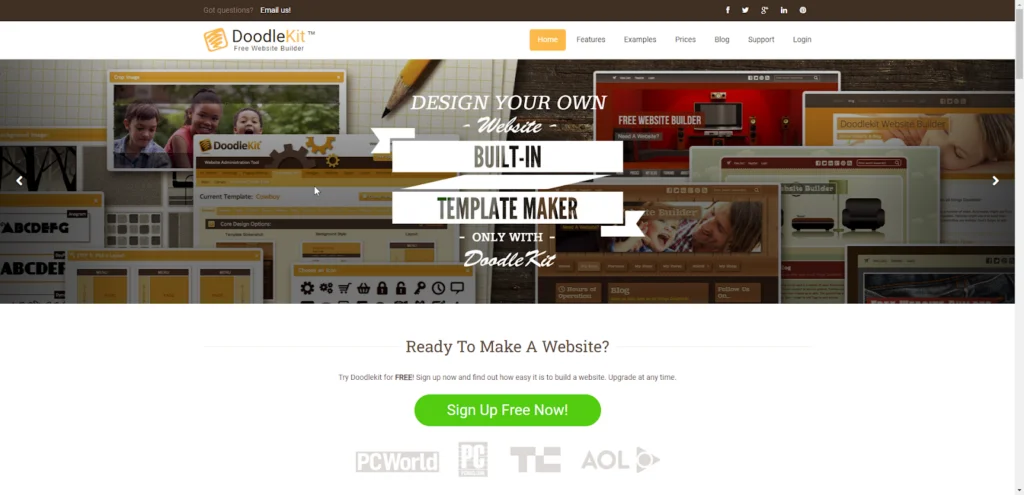
DoodleKit is a website builder that makes it easy for you to launch your small business website. If you’re someone who doesn’t know how to code, this builder can help you build your website in less than an hour without touching a single line of code.
If you’re looking for a website builder to build your first website, here’s a tip: any website builder that lacks professional-looking, modern design templates isn’t worth your time. DoodleKit fails horribly in this regard.
Their templates might have looked great a decade ago. But compared to the templates other, modern website builders offer, these templates look like they were made by a 16-year-old who just started learning web design.
DoodleKit might be helpful if you’re just starting out, but I wouldn’t recommend purchasing a premium plan. This website builder hasn’t been updated in a long time.
Read more
The team behind it might have been fixing bugs and security issues, but it seems like they haven’t added any new features in a long time. Just look at their website. It still talks about basic features such as file uploading, website statistics, and image galleries.
Not only are their templates super-old, but even their website copy also seems decades old. DoodleKit is a website builder from the era when personal diary blogs were getting popular. Those blogs have died out now, but DoodleKit still hasn’t moved on. Just take one look at their website and you’ll see what I mean.
If you want to build a modern website, I would highly recommend not going with DoodleKit. Their own website is stuck in the past. It is really slow and hasn’t caught up with modern best practices.
The worst part about DoodleKit is that their pricing starts at $14 per month. For $14 per month, other website builders will let you create a full-blown online store that can compete with giants. If you’ve looked at any of DoodleKit’s competitors, then I don’t need to tell you how expensive these prices are. Now, they do have a free plan if you want to test the waters, but it’s severely limiting. It even lacks SSL security, meaning no HTTPS.
If you’re looking for a much better website builder, there are dozens of others that are cheaper than DoodleKit, and offer better templates. They also offer a free domain name on their paid plans. Other website builders also offer dozens and dozens of modern features that DoodleKit lacks. They are also much easier to learn.
2. Webs.com
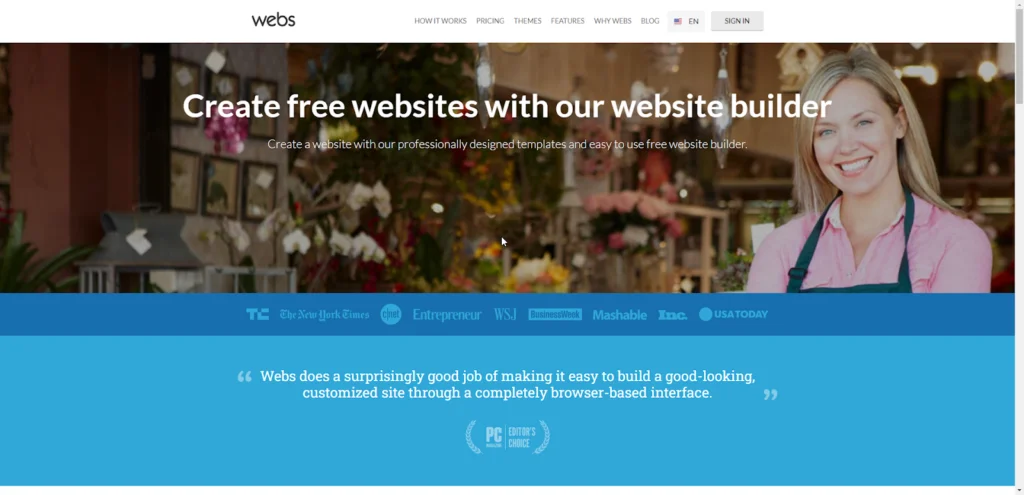
Webs.com (formerly freewebs) is a website builder aimed at small business owners. It’s an all-in-one solution for taking your small business online.
Webs.com got popular by offering a free plan. Their free plan used to be really generous. Now, it’s only a trial (although without a time limit) plan with lots of limits. It only allows you to build up to 5 pages. Most features are locked behind paid plans. If you are looking for a free website builder to build a hobby site, there are dozens of website builders in the market that are free, generous, and much better than Webs.com.
This website builder comes with dozens of templates you can use to build your website. Just choose a template, customize it with a drag-and-drop interface, and you’re ready to launch your site! Although the process is easy, the designs are really outdated. They are no match for the modern templates offered by other, more modern, website builders.
Read more
The worst part about Webs.com is that it seems that they have stopped developing the product. And if they’re still developing, it’s going at a snail’s pace. It’s almost as if the company behind this product has given up on it. This website builder is one of the oldest and used to be one of the most popular.
If you search for user reviews of Webs.com, you’ll notice that the first page of Google is filled with terrible reviews. The average rating for Webs.com around the internet is less than 2 stars. Most reviews are about how terrible their customer support service is.
Putting all the bad stuff aside, the design interface is user-friendly and easy to learn. It will take you less than an hour to learn the ropes. It’s made for beginners.
Webs.com’s plans start as low as $5.99 per month. Their basic plan allows you to build an unlimited number of pages on your website. It unlocks almost all the features except eCommerce. If you want to start selling on your website, you’ll need to pay at least $12.99 per month.
If you are someone with very little technical knowledge, this website builder might seem like the best option. But it’ll only seem so until you check out some of their competitors. There are a lot of other website builders in the market that are not only cheaper but offer a lot more features.
They also offer modern design templates that will help your website stand out. In my years of building websites, I’ve seen many website builders come and go. Webs.com used to be one of the best back in the day. But now, there’s no way I can recommend it to anyone. There are too many better alternatives in the market.
3. Yola

Yola is a website builder that helps you create a professional-looking website without any design or coding knowledge.
If you are building your first website, Yola could be a good choice. It’s a simple drag-and-drop website builder that lets you design your website yourself without any programming knowledge. The process is simple: pick one of the dozens of templates, customize the look and feel, add some pages, and hit publish. This tool is made for beginners.
Yola’s pricing is a huge deal-breaker for me. Their most basic paid plan is the Bronze plan, which is only $5.91 per month. But it doesn’t remove the Yola ads from your website. Yes, you heard it right! You’ll pay $5.91 per month for your website but there will be an ad for the Yola website builder on it. I really don’t understand this business decision… No other website builder charges you $6 a month and displays an ad on your website.
Although Yola could be a great starting point, once you get started, you’ll soon find yourself looking for a more advanced website builder. Yola has everything you need to get started building your first website. But it lacks a lot of features you’ll need when your website starts gaining some traction.
Read more
You can integrate other tools into your website to add these features to your website, but it’s too much work. Other website builders come with built-in email marketing tools, A/B testing, blogging tools, an advanced editor, and better templates. And these tools cost just as much as Yola.
A website builder’s main selling point is that it lets you build professional-looking websites without having to hire an expensive professional designer. They do this by offering you hundreds of stand-out templates that you can customize. Yola’s templates are really uninspired.
They all look exactly the same with some minor differences, and none of them stands out. I don’t know if they only hired one designer and asked her to do 100 designs in one week, or if it’s the limitation of their website builder tool itself. I think it might be the latter.
One thing I do like about Yola’s pricing is that even the most basic Bronze plan allows you to create up to 5 websites. If you are someone who wants to build a lot of websites, for some reason, Yola is a great choice. The editor is easy to learn and comes with dozens of templates. So, creating a lot of websites should be really easy.
If you want to try Yola, you can try their free plan, which lets you build two websites. Of course, this plan is intended as a trial plan, so it doesn’t allow using your own domain name, and displays an ad for Yola on your website. It’s great for testing the waters but it lacks a lot of features.
Yola also lacks a really important feature that all other website builders offer. It doesn’t have a blogging feature. This means you can’t create a blog on your website. This just baffles me beyond belief. A blog is just a set of pages, and this tool allows you to create pages, but it doesn’t have a feature to add a blog to your website.
If you want a quick and easy way to build and launch your website, Yola is a good choice. But if you want to build a serious online business, there are a lot of other website builders that offer hundreds of important features Yola lacks. Yola offers a simple website builder. Other website builders offer an all-in-one solution for building and growing your online business.
4. SeedProd
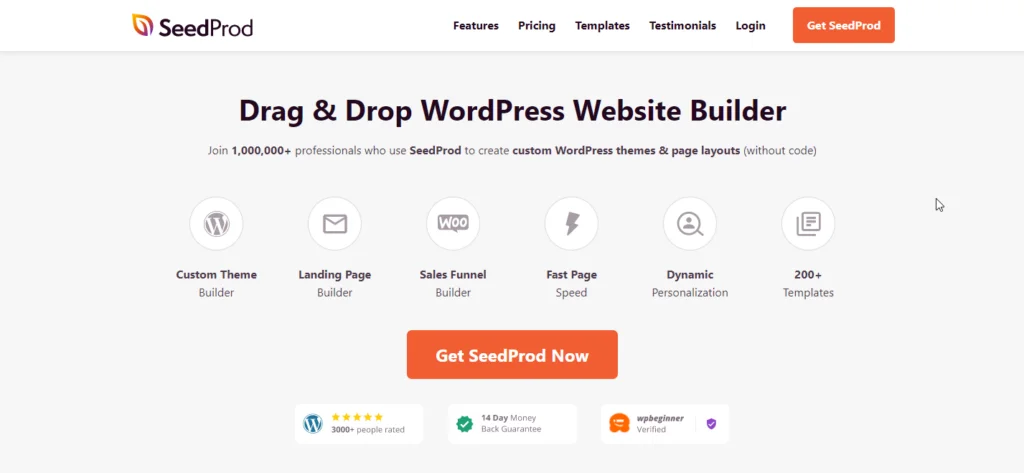
SeedProd is a WordPress plugin that helps you customize the look and feel of your website. It gives you a simple drag-and-drop interface to customize the design of your pages. It comes with over 200 templates that you can choose from.
Page builders like SeedProd allow you to take control of the design of your website. Want to create a different footer for your website? You can easily do it by dragging and dropping elements onto the canvas. Want to redesign your entire website yourself? That’s possible too.
The best part about page builders like SeedProd is that they are built for beginners. Even if you don’t have a lot of experience building websites, you can still build professional-looking websites without touching a single line of code.
Although SeedProd looks great at a first glance, there are some things you need to know before you make the decision to buy it. First off, compared to other page builders, SeedProd has very few elements (or blocks) that you can use when designing pages of your website. Other page builders have hundreds of these elements with new ones added every few months.
SeedProd might be a little more beginner-friendly than other page builders, but it lacks some features that you might need if you are an experienced user. Is that a drawback you can live with?
Read more
Another thing I didn’t like about SeedProd is that its free version is very limited. There are free page builder plugins for WordPress that offer dozens of features that the free version of SeedProd lacks. And although SeedProd comes with over 200 templates, not all of those templates are that great. If you are someone who wants their website’s design to stand out, take a look at the alternatives.
SeedProd’s pricing is a huge deal-breaker for me. Their pricing starts at only $79.50 per year for one site, but this basic plan lacks a lot of features. For one, it doesn’t support integration with email marketing tools. So, you can’t use the basic plan to create lead-capture landing pages or to grow your email list. This is a basic feature that comes free with a lot of other page builders. You also only get access to some of the templates in the basic plan. Other page builders don’t limit access this way.
There are a couple more things that I really don’t like about SeedProd’s pricing. Their full-website kits are locked behind the Pro plan which is $399 per year. A full-website kit lets you completely change the look of your website.
On any other plan, you might have to use a mix of many different styles for different pages or design your own templates. You’ll also need this $399 plan if you want to be able to edit your entire website including the header and footer. Once again, this feature comes with all other website builders even in their free plans.
If you want to be able to use it with WooCommerce, you’ll need their Elite plan which is $599 per month. You’ll need to pay $599 per year to be able to create custom designs for the checkout page, cart page, product grids, and singular product pages. Other page builders offer these features on almost all their plans, even the cheaper ones.
SeedProd is great if you’re made of money. If you are looking for an affordable page builder plugin for WordPress, I would recommend you take a look at some of SeedProd’s competitors. They are cheaper, offer better templates, and don’t lock their best features behind their highest pricing plan.
What is E-commerce Software?
E-commerce software is a powerful tool that enables businesses of all sizes to create and manage online stores. It’s the backbone of digital retail, providing the necessary infrastructure to list products, process payments, and handle shipping logistics. As someone who’s helped dozens of businesses transition to online sales, I’ve seen firsthand how e-commerce software can transform a small operation into a thriving digital enterprise.
The beauty of modern e-commerce platforms lies in their accessibility. You don’t need to be a tech wizard to get started. These tools offer user-friendly interfaces that allow even those with minimal technical skills to set up shop quickly. I remember helping a local artisan launch her first online store using WooCommerce. Within a week, she was selling handcrafted jewelry to customers across the country – something she never thought possible from her small workshop.
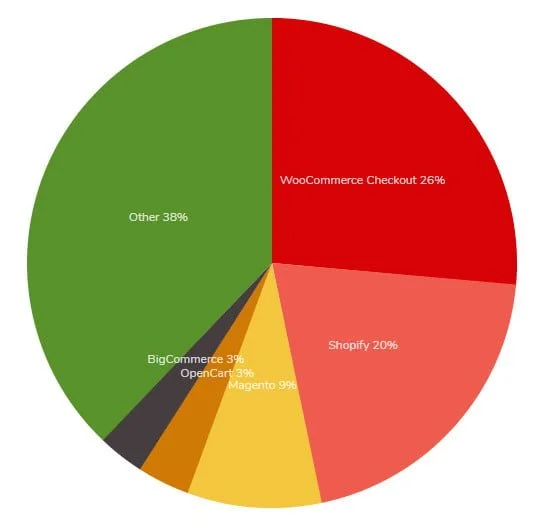
WooCommerce stands out as a giant in the e-commerce world. It’s not just popular; it’s dominant. According to the latest data from BuiltWith.com, WooCommerce powers an impressive 35% of all online stores globally. This statistic isn’t just a number – it represents millions of businesses that have chosen this platform to reach their customers online.
However, popularity doesn’t always equate to perfection. In my experience working with various e-commerce platforms, I’ve noticed that WooCommerce, while powerful, can be a double-edged sword. Its extensive feature set is a boon for some but can be overwhelming for others. I’ve had clients who loved the flexibility WooCommerce offered, allowing them to customize every aspect of their store. On the flip side, I’ve also worked with small business owners who found the learning curve steep and the ongoing maintenance demanding.
One common complaint I’ve heard from WooCommerce users is about the hidden costs. While the core plugin is free, many essential features require paid extensions. This can quickly add up, eating into profits, especially for smaller businesses. I once audited a client’s WooCommerce setup and found they were spending over $500 annually on plugins alone – a significant expense for their modest operation.
If you’ve been using WooCommerce and find yourself nodding along to these points, you’re not alone. The good news is that the e-commerce software market is diverse and constantly evolving. There are numerous alternatives that might better suit your specific needs.
For instance, I recently migrated a client from WooCommerce to Shopify. They were struggling with site performance and constant updates. After the switch, their page load times improved dramatically, and they appreciated the all-in-one nature of Shopify’s platform. Another client found success with BigCommerce, particularly loving its robust inventory management features that WooCommerce lacked out of the box.
Shopify is one of the best alternatives to WooCommerce. It’s both easier and cheaper to use than much other e-commerce software (including WooCommerce itself). Other alternatives include Wix, Bigcommerce, and Ecwid.
What is WooCommerce?
WooCommerce is the e-commerce cousin of WordPress.
WooCommerce is a WordPress ecommerce plugin that easily integrates ecommerce capabilities with your existing WordPress site, it’s free, open-source and extensible.
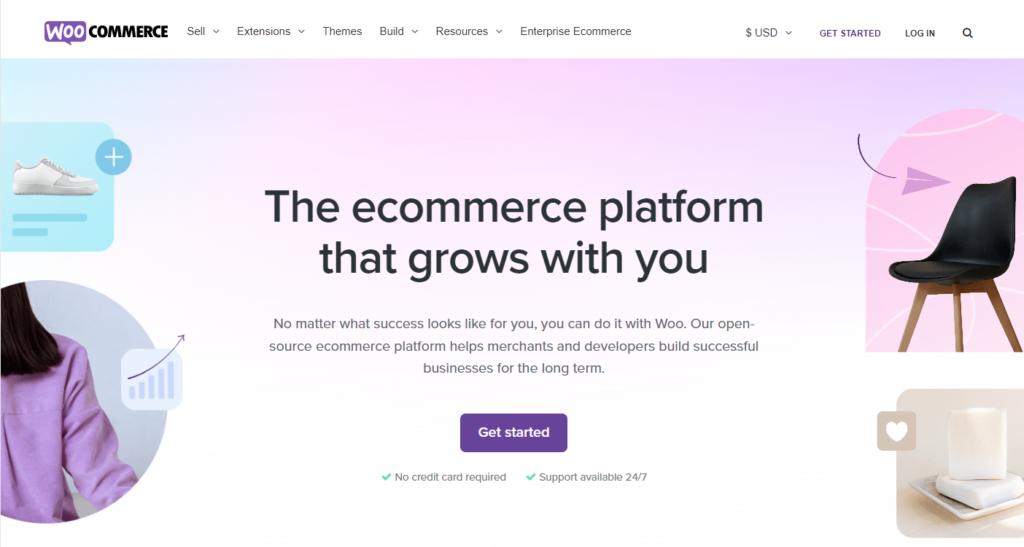
It’s been in business since the year 2011, and it’s offered as an easy-to-use website plugin for websites that allows you to set up a store in just a few minutes.
For an idea of just how popular WooCommerce is, internet statistics from 2024 say that as much as 35% of all e-commerce sites on the Internet were run by WooCommerce.

Pros and Cons of WooCommerce
The pros of WooCommerce are that it’s easy to sign up for, it’s easy to use and it’s cheap to start off with – but once you’ve used WooCommerce for a few weeks, it’s likely that you are going to start looking for alternatives to the WooCommerce ecosystem.
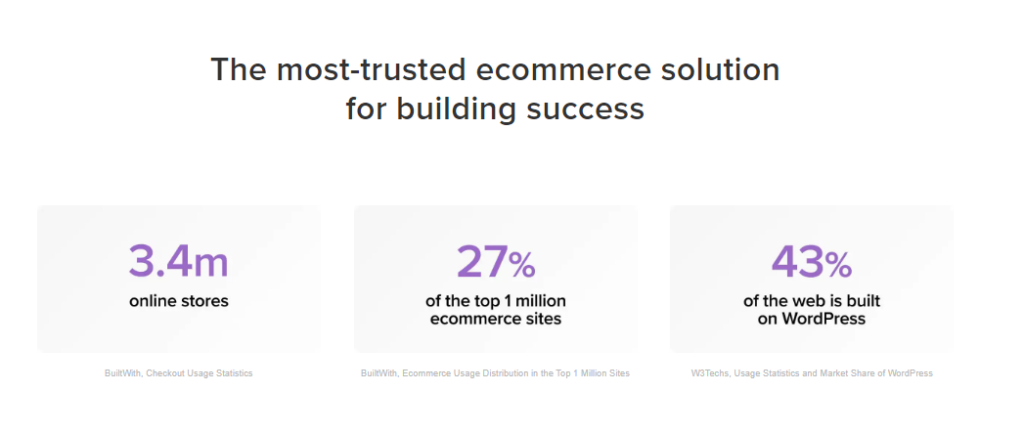
WooCommerce pros include:
- WooCommerce itself is a free plugin (but there are costs to using WooCommerce as you need to pay for a web hosting service, usually also a premium theme and extensions).
- It’s open-source which means the customization possibilities are limitless. It’s no wonder that WooCommerce calls itself “the world’s most customizable e-commerce platform”.
- Thousands of great-looking, e-commerce-ready, and mobile-responsive WordPress themes exist for WooCommerce.
- WooCommerce is a great option for technically-skilled store owners that want a hands-on approach.
The cons of WooCommerce are:
- A lack of customer support for clients and customers who are in need of immediate or urgent help.
- WooCommerce gets expensive with paid options, and free options have proved to be far too limiting for users.
- The WooCommerce system is easy to use and set up but becomes harder to navigate the larger your commerce venture or shop becomes.
- Security concerns have prompted even more users to make the switch to other platforms.
- Is self-hosted meaning you have to look after the “code”, as opposed to Shopify which takes care of the technical maintenance of running a store for you.
Our Verdict ⭐
WooCommerce remains a powerhouse in the e-commerce world, powering almost 35% of online stores globally. Its popularity stems from its robust features, flexibility, and integration with WordPress. However, after testing numerous alternatives, I’ve found that other platforms can offer distinct advantages depending on your specific needs.
Choosing between WooCommerce and its alternatives boils down to two key factors: your current web presence and your product catalog size. Here’s a breakdown based on my experience setting up dozens of online stores:
- For new online stores, Shopify stands out as the top choice. As a comprehensive e-commerce solution, Shopify offers unparalleled ease of use. I’ve set up stores for clients in various industries, and Shopify’s intuitive interface and built-in features consistently impress. Its app ecosystem rivals WooCommerce’s plugin library, offering extensive customization options.
- For small catalogs or businesses just dipping their toes into e-commerce, Wix offers a compelling package. Its drag-and-drop interface makes creating a professional-looking store a breeze. I’ve used Wix for several small business clients, and its e-commerce features, while not as extensive as Shopify’s, are more than sufficient for most small-scale operations.
- If you’re already running a WordPress site, BigCommerce offers a unique advantage. Its WordPress integration allows you to maintain your existing site while leveraging BigCommerce’s robust e-commerce backend. I’ve migrated several WooCommerce stores to this setup, and clients appreciate the improved performance and scalability without sacrificing their familiar WordPress environment.
Each of these alternatives addresses common pain points I’ve encountered with WooCommerce. Shopify eliminates the need for separate hosting and simplifies maintenance. Wix combines website building and e-commerce in one platform, ideal for those starting from scratch. BigCommerce offers enterprise-level features while maintaining WordPress flexibility.
Ultimately, the best choice depends on your specific needs, technical expertise, and growth plans. Consider factors like scalability, payment options, and international selling capabilities when making your decision. Remember, the right platform should grow with your business, not hold it back.

